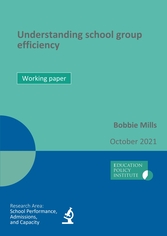Chancellor Rishi Sunak confirmed last month that spending per pupil in schools will be restored to 2010 levels in real-terms by 2024-25. On the one hand, this was not unexpected, as we know that this has been the intention since Boris Johnson’s first months as Prime Minister. Although, on the other, it’s fair to say that a lot has changed for education since the ambition was first announced in 2019.
While the original pre-pandemic ambitions for school funding have not sufficiently shifted in accordance with the challenges brought by the last 18 months, the welcome reversal of several years of real-terms cuts does now seem a smaller prize in the face of the financial pressures brought by educating in a pandemic and the years of education recovery to come.
Despite Sunak’s announcement of an additional £1.8bn for education recovery, bringing the total to £4.9bn, funding for education recovery in England is still significantly less than the level of funding committed by other developed nations. EPI analysis has found that it amounts to £490 per pupil, while education catch-up plans in the Netherlands amount to around £2,100 per pupil and in the United States to around £1,800 per pupil.
No matter how much the government spends on schools (about £49 billion in revenue funding to schools in England for 2021-22, now set to rise to about £56 billion by 2024-25) both leaders and policymakers alike need to know that resources are being put to best use.
It is right to expect school leaders to ensure that the best possible outcomes are achieved for young people with as efficient and sustainable use of resources as possible. No one holds these expectations more highly than school leaders themselves, and this is partly what drives spending decisions in schools up and down the country. As budgets have come under renewed pressure from the pandemic, it continues to be important to understand how schools can make genuine efficiency savings without compromising the quality or sustainability of their education and workforce.
Efficiency means sustainably achieving the best outcomes for young people without unnecessary use of resources
But it’s difficult to know whether a school is being efficient with its resources, let alone which schools are most efficient. This is partly because there is no accepted right way of allocating resources or of how to run a successful school. For example, school leaders may choose to invest more in teaching assistants, while others might invest in a lower number of more experienced (and more expensive) teaching staff. Beyond choices over allocating resources, there is no accepted right measure of the outcomes that schools should be achieving with their money.
With such diversity of school operations and contexts, can a school or trust’s efficiency really be measured and compared with another?
Efficiency isn’t simple to measure, but it’s important for understanding how schools best work together in numbers
Efficiency is a central dimension to how schools might benefit from working together in numbers, but we have yet to understand whether efficiencies are being achieved.
The underlying theory of today’s education policy landscape is that improvement in education can be best achieved with effective school leaders working through groups and networks. The multi-academy trust is at the heart of this: over three-quarters of secondary-aged pupils and nearly two in every five primary-aged pupils are now being educated in academies and free schools.[1]
Nevertheless, MATs are just one way in which schools can work together in numbers. A significant proportion of schools, particularly primary schools, remain outside the academy system. In fact, in 47 of the 152 local authority areas in England, less than a quarter of primary schools are part of academies or free schools.[2] Our mixed system also encompasses schools in federations, foundation school trusts, and those of religious denomination which have important relationships with their diocese. Schools in the same local authorities are not grouped by governance but nevertheless are linked through local communities, leadership networks and, not least, their relationships with their local Children’s Services. This relationship can influence a range of things including budget, admissions and school improvement. Meanwhile, there are standalone academies and free schools that are separate from any of these group types.
We know that there is some divergence in how local authority schools and academy trusts of different sizes spend their money and not all of it can be accounted for by their different pupil intakes. Divergent spending practices can be seen, for example, in how teaching staff are deployed. Larger trusts spend less on average per classroom teacher, partly because they are more likely to employ a greater proportion of new entrants, but also potentially because some of the largest trusts have been at the forefront of embedding curriculum-based financial planning in their schools. Meanwhile, per-pupil spending on ‘back office’ functions remains substantially lower in local authority schools in comparison with MATs, particularly in areas with low-levels of academisation. This last raises questions about whether economies of scale for trusts are achievable in the ways we might expect. Further, the differences we observe between how different school groups deploy their teaching staff raise the question of quality: the concept of efficiency demands that lower use of resources still produces positive results for pupils and for workforce sustainability.
Looking at efficiency will help us link our knowledge of school spending to school outcomes and help us understand whether and how schools are reaping the potential benefits of working together in groups.
There are multiple types of school group and there are schools from across all of these group types achieving excellent outcomes for children and young people. There are others, again in all of these group types, achieving less well for young people. We have worked in the past to compare the performance of MATs and LAs and found little to recommend one over the other. Our conclusion was that the type of school – academy or local authority – is less important than being in a high performing school group; both academy chains and local authorities feature at the very top and the very bottom of our performance tables. Furthermore, we know comparatively little about outcomes achieved by schools that work together in other ways, for example through forming federations or providing support and governance through a network of diocese schools.
The question, then, is not which type of school group is optimal, but rather which individual school groups are the most effective, and what are the defining features of their success in working in numbers?
This is the question we aim to answer with an ambitious work programme that will span the next few years, and which we have already made a start on.
The first step is defining “effective”. Our approach is to divide it into four domains: effective school groups should achieve a balance of strong outcomes across (1) pupil outcomes; (2) workforce sustainability; (3) pupil inclusion and (4) financial efficiency. We are in the process of developing metrics for school groups across these four domains which we will develop and refine in light of feedback.
In October we published our first methodology paper discussing our proposed approach to measuring efficiency in school groups. With it we opened a consultation which closed on November 16. However, we still encourage you to share your views with us – this can be done here.
We greatly value feedback from education leaders and sector experts and would welcome your thoughts.
This is the first in a number of blogs which will unpack our approach to efficiency and how it compares with existing approaches to benchmarking school expenditure and efficiency.
[1] DfE, ‘Schools, pupils and their characteristics’, Academic Year 2020/21
[2] EPI analysis of ‘Get Information About Schools’, 4th November 2021, includes all-through schools and middle schools that are deemed primary.


